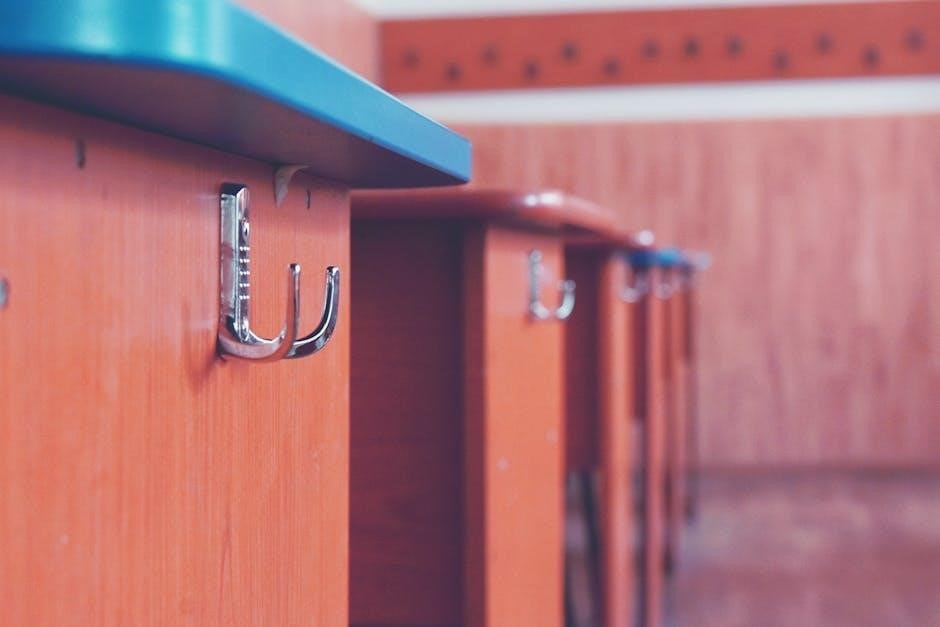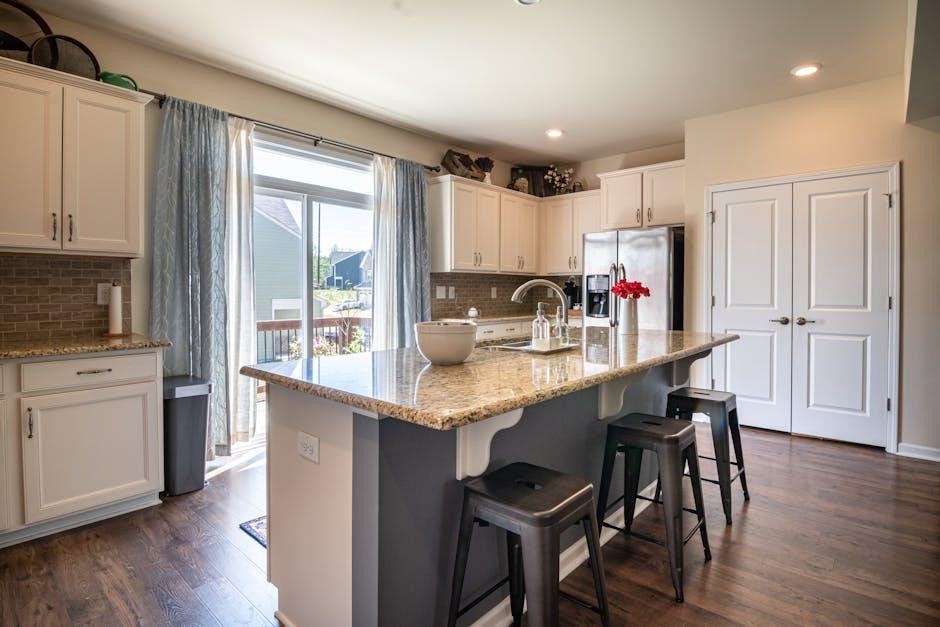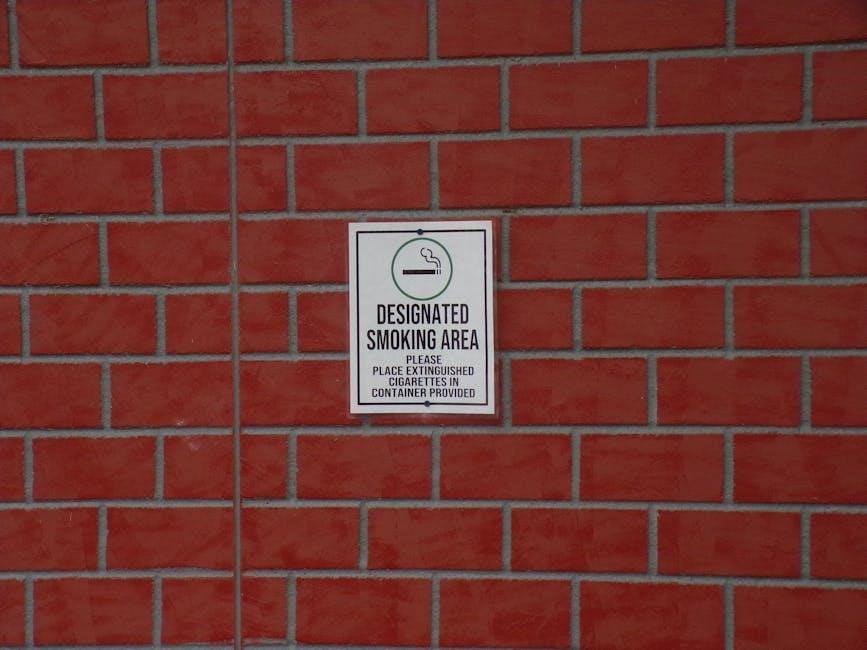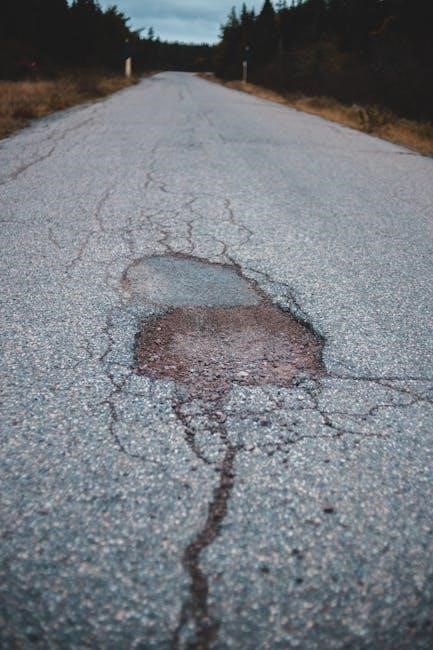Surface Area Worksheets are essential for math education, providing problems on prisms, cubes, and more. They include answers for self-assessment and are available in PDF formats, suitable for all grade levels.
1.1 What Are Surface Area Worksheets?
Surface area worksheets are educational resources designed to help students practice calculating the surface area of various three-dimensional shapes. These worksheets typically include problems involving rectangular prisms, triangular prisms, cubes, and other polyhedrons. They often provide diagrams, measurements, and formulas to guide students in their calculations. Many worksheets include answer keys, allowing students to verify their work and improve their understanding. Available in PDF formats, these tools are versatile and accessible for students of all grade levels, from elementary to college, making them a valuable asset for math education and skill development.
1.2 Importance of Surface Area Worksheets in Math Education
Surface area worksheets play a crucial role in math education by helping students develop problem-solving skills and understand geometric concepts. They provide structured practice for calculating surface areas of various shapes, enhancing spatial reasoning and mathematical accuracy. These worksheets are particularly useful for reinforcing lessons on prisms, cubes, and other polyhedrons. By offering clear problems and solutions, they enable students to grasp complex formulas and apply them effectively; Regular use of these resources builds confidence and prepares students for advanced math challenges, making them an indispensable tool for educators and learners alike.
1.3 Benefits of Using Worksheets with Answers
Worksheets with answers provide immediate feedback, enabling students to verify their solutions and identify errors. This self-assessment tool enhances learning by allowing students to review mistakes and understand correct methods. PDF formats ensure accessibility and ease of use, catering to various grade levels. Detailed solutions offer step-by-step explanations, fostering a deeper understanding of surface area calculations. These resources save time for educators and reinforce concepts for students, making them invaluable for both classroom and independent study. Regular practice with such worksheets improves problem-solving skills and builds confidence in math abilities.

Types of Surface Area Worksheets
Surface area worksheets cover various shapes, including rectangular prisms, triangular prisms, cubes, and composite figures. They are designed for different skill levels and are available in PDF formats online.
2.1 Rectangular Prism Surface Area Worksheets
Rectangular prism surface area worksheets focus on calculating the surface area of boxes and similar 3D shapes. They typically include problems involving length, width, and height measurements. Students are tasked with applying the formula: 2(lw + lh + wh). These worksheets often feature real-world applications, such as calculating the surface area of packaging materials or architectural designs. Many PDF resources include answer keys, allowing students to verify their solutions. Advanced versions may incorporate unit conversions or mixed problems with other shapes. These exercises are ideal for developing spatial reasoning and math skills in geometry.
2.2 Triangular Prism Surface Area Worksheets
Triangular prism surface area worksheets focus on calculating the surface area of three-dimensional shapes with triangular bases. These worksheets often include problems involving base perimeter, height, and lateral surface calculations. The formula 2(½ × base × height) + (perimeter × length) is commonly used. They cater to various skill levels, from basic calculations to complex composite figures. Many PDF resources provide step-by-step solutions and answer keys, helping students master the concept. These exercises are particularly useful for geometry classes, promoting understanding of spatial relationships and practical applications in engineering and architecture.
2.3 Cube and Cuboid Surface Area Worksheets
Cube and cuboid surface area worksheets focus on calculating the total surface area of these uniform and rectangular-based 3D shapes. For cubes, the formula 6s² is used, while cuboids use 2(lw + lh + wh). Worksheets often include problems with varying edge lengths, requiring students to apply these formulas. Mixed exercises may involve finding missing dimensions or comparing surface areas of different cubes and cuboids. These resources are ideal for practicing geometry concepts and are available in PDF formats with answers for quick verification and learning. They are suitable for students of all skill levels, from elementary to high school.

How to Calculate Surface Area
Calculating surface area involves summing the areas of all exposed faces. For prisms, it’s done by finding the perimeter of the base and multiplying by height, while for cubes, it’s 6s². Nets are often used to visualize and calculate surface area effectively. Understanding these methods is crucial for mastering geometry and real-world applications.
3.1 Surface Area of Rectangular Prisms
The surface area of a rectangular prism is calculated using the formula: 2(lw + lh + wh), where l is length, w is width, and h is height. This formula accounts for all six faces of the prism. To find the surface area, simply plug in the dimensions into the formula and perform the calculations. For example, if the length is 5 cm, width is 3 cm, and height is 2 cm, the surface area would be 2(5×3 + 5×2 + 3×2) = 2(15 + 10 + 6) = 2(31) = 62 cm². Practice worksheets with answers provide excellent opportunities to master this concept. These resources often include various problems to ensure a thorough understanding of surface area calculations for rectangular prisms. Additionally, many educational websites offer free PDF downloads of surface area worksheets, making it easy to find and print practice materials. Regular practice helps students become proficient in applying the formula and solving real-world problems involving rectangular prisms.
3;2 Surface Area of Triangular Prisms
The surface area of a triangular prism is calculated by adding the areas of all its faces. It consists of two triangular bases and three rectangular sides. The formula for the surface area is: 2 × (Area of Triangular Base) + (Perimeter of Triangular Base × Height of Prism). To find the area of the triangular base, use the formula (base × height) / 2. For example, if the base of the triangle is 4 cm, the height is 5 cm, and the prism’s height is 6 cm, the surface area would be 2 × (4×5/2) + (4+5+4) × 6 = 20 + 78 = 98 cm². Practice worksheets with answers provide numerous exercises to master this concept, ensuring students understand how to apply the formula correctly. These resources are widely available in PDF formats, making it easy to access and print for homework or classroom use. Regular practice helps build confidence in calculating the surface area of triangular prisms for various problems.
3.3 Surface Area of Cubes and Cuboids
The surface area of a cube is calculated using the formula 6s², where s is the length of one side. For a cuboid, the formula is 2(lw + lh + wh), where l, w, and h represent length, width, and height. Worksheets often include problems with varying dimensions, such as a cube with a side length of 5 cm or a cuboid with dimensions 4 cm, 3 cm, and 2 cm. For example, the surface area of a cube with side 5 cm is 6 × 25 = 150 cm². Practice exercises with answers help students master these calculations. PDF worksheets with solutions are widely available, making it easy to learn and apply these formulas to different shapes and sizes. Regular practice ensures comprehension and fluency in calculating surface areas of cubes and cuboids.

Surface Area Worksheets with Answers
Surface Area Worksheets with Answers provide comprehensive practice for students, offering problems and solutions in PDF formats. They cover various shapes and include detailed answer keys for self-assessment.
4.1 Free PDF Downloads for Surface Area Worksheets
Free PDF downloads for surface area worksheets are widely available online, offering a convenient way to practice calculations. These worksheets cover various shapes, including rectangular and triangular prisms, cubes, and more. Many resources provide answers, enabling students to check their work and improve understanding. They are suitable for different grade levels, from elementary to high school, and are easily downloadable for offline use. Websites like KutaSoftware and Cluey Learning offer editable versions, while others provide ready-to-print sheets. These PDFs are a valuable tool for teachers and students alike, promoting consistent practice and mastery of surface area concepts.
4.2 Worksheets for Middle School Students
Worksheets designed for middle school students focus on building foundational skills in calculating surface areas of various 3D shapes. These resources often include problems involving rectangular prisms, triangular prisms, and cubes, with step-by-step solutions. Many worksheets incorporate word problems and unit conversions to enhance practical understanding. They are created to align with curriculum standards, ensuring relevance and effectiveness. Free PDF downloads are widely available, offering teachers and parents convenient tools for homework or classwork. These sheets are ideal for reinforcing lessons and helping students master surface area calculations in a structured and engaging manner.
4.3 Advanced Surface Area Problems with Solutions
Advanced surface area problems with solutions cater to high school and college-level students, offering complex scenarios involving composite shapes, irregular prisms, and multi-step calculations. These worksheets include challenges like finding the surface area of combined solids, applying unit conversions, and solving real-world applications. Detailed solutions are provided to guide students through intricate calculations, ensuring a deeper understanding of geometric concepts. They are ideal for preparing students for standardized tests and fostering advanced problem-solving skills in math and engineering-related fields.

Using Nets to Calculate Surface Area
Nets are visual representations of 3D shapes unfolded into 2D. They help students understand and calculate surface areas by summing the areas of all individual faces.
5.1 Understanding Nets of 3D Shapes
Nets are two-dimensional representations of three-dimensional shapes, such as prisms and cubes, unfolded into flat patterns. They consist of connected rectangles or triangles that, when folded, form the original 3D object. Understanding nets is crucial for calculating surface areas, as they allow students to visualize and sum the areas of all individual faces. For example, a cube’s net comprises six squares, while a triangular prism’s net includes two triangular bases and three rectangular sides. Worksheets often include nets to help students practice identifying and calculating surface areas accurately. These exercises are particularly effective for visual learners and are widely available in PDF formats with answers for self-assessment;
5.2 How to Use Nets to Find Surface Area
To find the surface area of a 3D shape using its net, identify all the faces and calculate the area of each. For example, a rectangular prism’s net includes six rectangles—two of each pair of identical faces. Measure or identify the length and width of each rectangle, then use the formula Area = length × width. Sum the areas of all faces to get the total surface area. Nets simplify the process by flattening the shape, making it easier to visualize and compute. Worksheets with nets and answers provide guided practice for mastering this method.
5.3 Examples of Nets for Rectangular and Triangular Prisms
Nets are two-dimensional representations of three-dimensional shapes, aiding in surface area calculations. For a rectangular prism, a net consists of six rectangles, while a triangular prism’s net includes two triangular bases and three rectangular faces. These diagrams allow students to visualize and calculate the surface area by summing the areas of all faces. Worksheets often provide labeled nets for practice, ensuring clarity. By analyzing these examples, learners can better understand how nets simplify complex surface area problems, making calculations more accessible and straightforward. This method is particularly effective for visual learners and reinforces geometric concepts effectively.

Surface Area Worksheets for Different Grade Levels
Surface area worksheets cater to various grade levels, from elementary to college. They progress from basic concepts for younger students to complex problems for advanced learners, ensuring a smooth learning curve. Answer keys are often included for self-assessment and understanding.
6.1 Surface Area Worksheets for Elementary Students
Surface area worksheets designed for elementary students introduce foundational concepts through simple, engaging exercises. These worksheets often feature visual aids like nets of cubes and rectangular prisms, helping young learners understand how surfaces combine to form 3D shapes. Problems are typically straightforward, focusing on basic shapes and whole numbers. Many worksheets include answer keys, allowing students to check their work and learn from mistakes. Available in PDF formats, these resources are ideal for classroom use or homework, providing a clear and structured way to build math skills from an early age.
6.2 Surface Area Worksheets for High School Students
Surface area worksheets tailored for high school students offer advanced exercises to deepen understanding of 3D geometry. These worksheets typically include problems involving rectangular prisms, pyramids, and cylinders, often incorporating real-world applications like architecture or engineering. Students are challenged to calculate surface areas using formulas and nets, with some problems requiring unit conversions or mixed operations. Available in PDF formats, these resources often include answer keys for self-assessment. They are designed to prepare students for standardized tests and higher-level math courses, reinforcing problem-solving skills and mathematical precision.
6.3 Surface Area Worksheets for College-Level Math
Surface area worksheets for college-level math provide advanced exercises tailored for higher education. These resources focus on complex geometric shapes, such as irregular prisms, pyramids, and composite solids, often requiring the application of calculus and vector analysis. Problems emphasize real-world scenarios, including engineering and architecture, to enhance practical understanding. Worksheets typically include challenging calculations involving unit conversions and advanced problem-solving techniques. Detailed solutions and explanations are often provided to aid in understanding intricate concepts. These materials are essential for students preparing for exams or pursuing careers in STEM fields, where mastery of surface area calculations is critical.

Practice Exercises and Answer Keys
Practice exercises with answer keys provide students with comprehensive problems to master surface area calculations. Includes mixed problems, word problems, and unit conversion exercises in PDF formats.
7.1 Mixed Surface Area Problems with Solutions
Mixed surface area problems with solutions offer a variety of exercises, combining different shapes like prisms, cubes, and composite figures. These worksheets include step-by-step solutions, enabling students to understand problem-solving strategies. They cover surface area calculations for rectangular prisms, triangular prisms, and cubes, with answers provided for self-assessment. The problems often involve unit conversions, real-world applications, and complex composite shapes. Mixed problems help students apply their knowledge across different scenarios, ensuring a comprehensive understanding of surface area concepts. These resources are ideal for reinforcing math skills at various grade levels, from elementary to high school.
7.2 Surface Area Word Problems
Surface area word problems provide real-world scenarios for calculating the surface area of various objects, such as boxes, prisms, and composite shapes. These problems often involve practical applications, like packaging design or construction materials. Students are required to interpret the context, identify necessary dimensions, and apply surface area formulas. Worksheets with answers offer step-by-step solutions, helping learners understand how to approach complex, open-ended questions. Word problems enhance critical thinking and problem-solving skills, making surface area concepts more engaging and relatable. They are available in PDF formats, catering to different grade levels and learning needs.
7.3 Surface Area Worksheets with Unit Conversions
Surface area worksheets with unit conversions combine mathematical skills with real-world applications, ensuring students master both calculations and measurement accuracy. These exercises often involve converting units such as meters to centimeters, inches to feet, or millimeters to meters before calculating surface areas. Problems may include scenarios like packaging materials or construction designs, requiring precise unit handling. Worksheets with answers provide clear guidance, helping students verify their results and understand common mistakes. Available in PDF formats, these resources cater to various grade levels, ensuring alignment with curriculum standards and enhancing problem-solving abilities.

Real-World Applications of Surface Area
Surface area knowledge is vital in architecture, engineering, and everyday life, aiding in material calculations, packaging design, and structural planning. Real-world problems enhance learning practicality.
8;1 Surface Area in Architecture

Surface area calculations are integral to architecture, aiding in material estimation, structural design, and energy efficiency. Architects use surface area to determine facade materials, insulation, and roofing requirements. It also plays a role in designing functional spaces while minimizing material waste. Additionally, surface area is crucial for assessing heat loss and gain, influencing heating and cooling systems. By applying these principles, architects can create sustainable and cost-effective buildings. Worksheets with answers provide architects and students with practical exercises to master these calculations, ensuring accuracy in real-world applications and fostering innovative designs.
8.2 Surface Area in Engineering
Surface area is a critical concept in engineering, influencing material selection, heat transfer, and structural design. Engineers use surface area calculations to optimize systems like pipelines, heat exchangers, and electronic components; It helps determine coating requirements, thermal performance, and stress distribution. For instance, in aerospace engineering, minimizing surface area reduces drag and enhances fuel efficiency. Additionally, surface area affects electrical resistance and signal transmission in circuits. Worksheets with answers provide engineers with practical tools to refine their calculations, ensuring precision in design and problem-solving. This skill is vital for developing efficient, safe, and cost-effective engineering solutions across various industries.
8.3 Surface Area in Everyday Life
Surface area plays a significant role in everyday activities, from wrapping gifts to painting walls. Understanding surface area helps in determining the amount of material needed for projects, like insulation in homes or packaging for products. It also applies to cooking and baking, where the size and shape of food items affect cooking times and results. Worksheets with answers provide practical examples, enabling individuals to apply mathematical concepts to real-world scenarios. This skill is essential for efficient problem-solving in various aspects of daily life, making surface area calculations a valuable tool for everyone.

Resources for Surface Area Worksheets
Find free surface area worksheets with answers in PDF and editable Word formats on websites like KutaSoftware.com and educational platforms offering math resources.
9.1 Websites Offering Free Surface Area Worksheets
Several websites provide free surface area worksheets with answers in PDF format. KutaSoftware.com offers customizable worksheets, while platforms like Cluey Learning and educational blogs share downloadable resources. These worksheets cater to various grade levels, from elementary to high school, and include problems for rectangular prisms, triangular prisms, and cubes. Many resources are editable, allowing teachers to tailor them to specific needs. Free PDF downloads ensure easy access for students and educators, making practice convenient and efficient. These websites are invaluable for supplementing math curricula and reinforcing surface area concepts through structured exercises.
9.2 How to Create Your Own Surface Area Worksheets
To create your own surface area worksheets, start by using tools like KutaSoftware or similar platforms. These tools allow you to generate custom problems for prisms, cubes, and other shapes. Ensure the problems are clear and include varying difficulty levels. Add visual aids like nets for complex shapes and provide an answer key for self-assessment. Use PDF formats for easy sharing and printing. This approach helps tailor worksheets to specific needs, making them more effective for teaching and learning surface area calculations.
9.4 Surface Area Worksheets with Answers in PDF Format
Surface area worksheets with answers in PDF format are widely available online, offering convenience and accessibility. These worksheets cover various shapes, such as prisms, cubes, and triangular prisms, with step-by-step solutions. They are ideal for students to practice and reinforce their understanding of surface area calculations. Many resources, like KutaSoftware, provide free downloadable PDFs tailored for different grade levels. These worksheets often include mixed problems, word problems, and unit conversions, making them comprehensive tools for math education. Regular practice with these PDFs helps build confidence and mastery in surface area concepts.
Surface area worksheets with answers in PDF format provide an excellent way to master calculations, offering practice and clarity for students of all levels, ensuring confidence and accuracy.
10.1 Summary of Key Points
Surface area worksheets with answers in PDF format are versatile tools for mastering calculations. They cater to various grade levels, ensuring accessibility for all learners. These resources provide clear problems, step-by-step solutions, and immediate feedback, enhancing understanding and confidence. Regular practice with these worksheets improves problem-solving skills and reinforces mathematical concepts. They also offer a structured approach to learning, making complex calculations manageable. Additionally, the inclusion of real-world applications highlights the practical relevance of surface area calculations. Overall, these worksheets are invaluable for students seeking to excel in geometry and related fields, offering a comprehensive and user-friendly learning experience.
10.2 Tips for Mastering Surface Area Calculations
To master surface area calculations, start by understanding the formulas for different shapes, such as prisms, cubes, and triangular prisms. Practice regularly using worksheets with answers to build accuracy. Use visual aids like nets to break down complex shapes into manageable parts. Focus on real-world applications to see the practical relevance of surface area calculations; Review mistakes to identify common errors and improve problem-solving strategies. Utilize answer keys for immediate feedback and self-assessment. Combine theoretical knowledge with practical exercises to reinforce learning. Consistency and patience are key to excelling in surface area problems.
10.3 Final Thoughts on the Importance of Practice
Consistent practice is the cornerstone of mastering surface area calculations. Regularly working through problems helps solidify understanding of formulas and techniques. Use worksheets with answers to track progress and identify areas needing improvement. Real-world applications highlight the relevance of these skills, motivating learners to engage deeply. By honing problem-solving abilities and attention to detail, practice builds confidence and proficiency. Over time, complex calculations become intuitive, enabling quick and accurate solutions. Embrace practice as a lifelong learning tool to excel in surface area challenges and beyond.